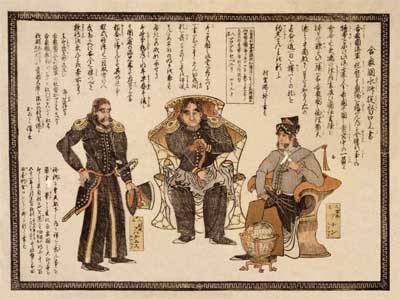Musical (1976)
Music and lyrics by Stephen Sondheim
Book by John Weidman
Additional material by Hugh Wheeler
Orchestrations by Jonathan Tunick
Stage Direction by Jim Petosa
Music Direction by Matthew Stern
Boston University College of Fine Arts
School of Theatre
Boston Center for the Arts
12/13 – 12/19/2013
Choreography by McCaela Donovan and Stephen Ursprung
Scenic Designer: Ryan Bates; Costume Designer: Chelsea Kerl
With Zachary Clarence (Councilor, Dutch Amiral, Priest), Charles Coursey, Jr. (Kayama), Matthew Dray (Priest, Russian Admiral, Samurai, Thief), Harrison Bryan (Fisherman, French Admiral, Madam, Samurai Companion), Evan Gambardella (Manjiro), Jesse Garlick (American Admiral, et al), Olliva Haller (Tamate, Storyteller, Girl), Rosie O’Leary (Councilor, et al), Rachel Rees (Perry, Shogun’s Wife), Elizabeth Sara Rich (Boy, Merchant’s son), John Scala (British Admiral, et al), Kristian Sorensen (Abe, Sailor, Shogun’s Mother), Ellen Tamak (Reciter, Shogun), Maria Timonina (Sumo Wrestler et al), Savanna Young-Norris (Sumo Wrestler et al)

“The Kabuki actors Bandō Zenji
(on the left, in the role of Onisadobō)
and Sawamura Yodogorō II
(on the right, as Kawatsura Hōgen)
in the play ‘Yoshitsune Senbon-Zakura'”
(“Yoshitsune of the Thousand Cherry-Trees”)
1794
Wikipedia
This Sondheim musical rests on more of a topically, rather than personally, inspired narrative. That topic is interesting, but, unlike a lot of Sondheim’s other works, its story is derived less from the distinctive qualities of its characters and more upon the impetus on a singular event, the opening of Japan to the West via Commodore Matthew Perry’s arrival in 1853.
It is not terribly surprising, for this reason, that this is one of Sondheim’s less performed shows. Though the original Broadway production was nominated for a slew of Tony awards in 1976, its less personal narrative, and its daring and unorthodox staging in kabuki style, did not draw enough audience to keep it afloat on Broadway for very long afterwards.
The show also hovers oddly on the boundary between historic commemoration and satire. It tries, sincerely, to convey the nature of traditional sensibilities that prevailed at the time of Commodore Perry’s appearance, and the shock that his appearance created. But, in the process, there is also a lot of showbiz vaudeville in the show. Some of it is funny, but some of its renderings of Japanese traditional culture seem stereotypical and weird. Having just been to Japan, I can only sense what Japanese people must feel about this kind of sometimes significantly caricaturish portrayal. Apparently, when the show was staged in Japanese by the New National Theater of Tokyo in 2002, it significantly, and not surprisingly, changed the way in which traditional Japanese culture was presented.
Though this show tries, in some ways and at some times, to be culturally sensitive, somehow I kept thinking of curious film portrayals of Japanese characters by Westerners, like Alec Guinness’ Mr. Asano in A Majority of One (1961), and ludicrous ones like Mickey Rooney’s Mr. Yunioshi in Breakfast at Tiffany’s (1961), when it did not quite succeed.
That being said, I enjoyed the show. Some of the songs are great and, like those many from Sondheim’s more esoteric scores, grow on one over time. The spoofs of the Russians, French and Americans in Please Hello with its obsessive-compulsive refrain “don’t touch the coat” are hysterical. The haunting meanderings of A Bowler Hat with its line “I read Spinoza every day,” or the syncopated lines of Someone in a Tree (which, reportedly at one time, was Sondheim’s favorite of all of his songs), are memorable.
There was really some wonderful staging in this production. The sets were simple but imaginative, and the way in which the rotating side screens were employed in some of the numbers was very effective.
The choreography by McCaela Donovan and Stephen Ursprung was varied and interesting throughout. There was a lot of it and it enhanced the production considerably. The costumes were inventive and colorful and made for a great, visually entertaining, display.

(“Oral statement by the American Navy admiral”) 1850-1900
Japanese woodblock of Commodore Perry (center)
and other American navy officers
Library of Congress
There was quite a bit of good acting throughout and some good singing.
The problem with producing a complex vocal and instrumental score like this is that it takes awhile to iron out the kinks. This student production did a heroic job of working within the parameters of this short run, but the fragility of Sondheim’s sometimes nonstandard tonalities was evident in various places both in sung and instrumental arenas. Also, I am not sure what the orchestration of the original calls for, but this variant for a small group sometimes seemed thin and oddly unbalanced, not quite up to conveying the exotic dramas of the score.
– BADMan
Leave a Reply